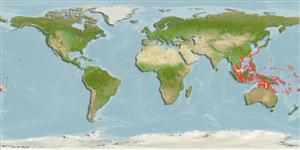>
Eupercaria/misc (Various families in series Eupercaria) >
Lutjanidae (Snappers) > Lutjaninae
Etymology: Lutjanus: Malay, ikan lutjan, name of a fish.
More on author: Lacepède.
Environment: milieu / climate zone / depth range / distribution range
Ökologie
seewasser riff-verbunden; tiefenbereich 3 - 50 m (Ref. 9710). Tropical; 35°N - 21°S, 93°E - 170°W
Western Pacific: Sumatra to Samoa, north to southern Japan. Apparently restricted to the western Pacific (Ref. 30829).
Size / Gewicht / Alter
Maturity: Lm ? range ? - ? cm
Max length : 35.0 cm TL Männchen/unbestimmt; (Ref. 48635); common length : 20.0 cm TL Männchen/unbestimmt; (Ref. 55)
Rückenflossenstacheln (insgesamt) : 10 - 11; Rückenflossenweichstrahlen (insgesamt) : 13 - 14; Afterflossenstacheln: 3; Afterflossenweichstrahlen: 8. Snout somewhat pointed. Eye large. Preorbital bone narrow, its width much less than eye diameter. Preopercular notch and knob well developed. Scale rows on back rising obliquely above lateral line. Generally pink or reddish, white or silvery below. Usually a series of ten to twelve stripes is on the side. Some specimens have black spot on the back below the anterior part of the soft dorsal fin.
Adults inhabit coral reefs. Often seen in schools near outcrops or drop-offs, often with other species (Ref. 9710), of up to about 30 to 40 individuals. Small juveniles on shallow algae reef, often near freshwater run-offs (Ref. 48635). Feed on fishes, shrimps, crabs, other crustaceans, cephalopods and some planktonic items.
Life cycle and mating behavior
Maturities | Fortpflanzung | Spawnings | Egg(s) | Fecundities | Larven
Allen, G.R., 1985. FAO Species Catalogue. Vol. 6. Snappers of the world. An annotated and illustrated catalogue of lutjanid species known to date. FAO Fish. Synop. 125(6):208 p. Rome: FAO. (Ref. 55)
IUCN Rote Liste Status (Ref. 130435)
Bedrohung für Menschen
Harmless
Nutzung durch Menschen
Fischereien: weniger kommerziell
Tools
Zusatzinformationen
Download XML
Internet Quellen
Estimates based on models
Preferred temperature (Ref.
123201): 24.3 - 29, mean 28.2 °C (based on 542 cells).
Phylogenetic diversity index (Ref.
82804): PD
50 = 0.5000 [Uniqueness, from 0.5 = low to 2.0 = high].
Bayesian length-weight: a=0.01479 (0.00706 - 0.03101), b=2.97 (2.81 - 3.13), in cm total length, based on LWR estimates for this Genus-body shape (Ref.
93245).
Trophic level (Ref.
69278): 3.8 ±0.56 se; based on food items.
Generation time: 1.8 ( na - na) years. Estimated as median ln(3)/K based on 1
growth studies.
Widerstandsfähigkeit (Ref.
120179): hoch, Verdopplung der Population dauert weniger als 15 Monate. (Preliminary K or Fecundity.).
Fishing Vulnerability (Ref.
59153): Low vulnerability (25 of 100).
Nutrients (Ref.
124155): Calcium = 48.7 [28.8, 77.0] mg/100g; Iron = 0.444 [0.285, 0.734] mg/100g; Protein = 18.3 [16.8, 19.7] %; Omega3 = 0.134 [0.089, 0.204] g/100g; Selenium = 56.7 [33.3, 99.0] μg/100g; VitaminA = 200 [38, 831] μg/100g; Zinc = 0.47 [0.35, 0.68] mg/100g (wet weight);
